-
Past "hyperthermals" offer clues about anticipated climate changes
Bursts of intense global warming that have lasted tens of thousands of years have taken place more frequently throughout history than previously believed; most of the events raised average global temperatures between 2° and 3° Celsius (3.6 and 5.4° F), an amount comparable to current conservative estimates of how much temperatures are expected to rise in coming decades as a consequence of anthropogenic global warming; most hyperthermals lasted about 40,000 years before temperatures returned to normal
-
-
Shock absorbers making buildings earthquake-proof
An upstate New York manufacturer has developed dampers, or shock absorbers, which increase the earthquake resistance of a building by threefold; the patented dampers are based on technology first developed by the military to protect U.S. missile silos against Russian attacks during the cold war
-
-
Minnesota braces for spring floods
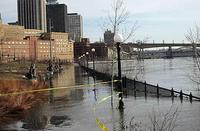
As dense snow packs in Minnesota begin to melt, officials are preparing for what may be their worst spring flooding yet; with record snow falls and heavy rains expected, weather officials are forecasting that floods are on their way; last September’s heavy rains saturated the soil with water which will exacerbate spring floods this year; officials are preparing the state for floods and St. Paul city officials have sent letters to all residents warning that they should find alternative places to stay and keep their vehicles in safe areas if they are forced to evacuate as water levels rise
-
-
Japan's nuclear crisis increasingly dire

Japan’s ongoing nuclear saga took a decided turn for the worse on Tuesday when a third explosion at a nuclear reactor may have cracked the containment unit protecting it, causing large amounts of radiation to leak out; the government requested assistance from the IAEA on Tuesday and teams were dispatched to help monitor radiation and human health; citizens within a thirteen mile radius of the Fukushima Daiichi power plant were evacuated and 140,000 residents within a twenty mile radius have been advised to stay indoors; officials also established a twenty mile no-fly zone around the power plant; officials in Tokyo reported that radiation levels were ten times their normal levels; experts say that these increased exposure levels do not pose an immediate threat to people, but the long-term effect remains unknown; the Tokyo Electric Power Company is considering using helicopters to pour cold water on top of overheating rooftops covering spent fuel rods; a small crew of fifty technicians at the badly damaged power plant is bravely fighting through high radiation levels and fires to contain the three reactors
-
-
EU considering subjecting nuclear plants to stress tests
The EU is considering subjecting the 150 nuclear reactors operating in Europe to stress test to check their safety in light of Japan’s nuclear crisis; the EU’s executive arm has no power to send experts to nuclear plants to see whether they are safe, but can discuss stress tests to see if EU nations would authorize them
-
-
Californians anxious about safety of nuclear reactors

The parallels between Japan and California are sobering: As in Japan, California’s two plants — Diablo Canyon near San Luis Obispo and San Onofre in Southern California — sit in active earthquake zones; like Japan’s, both rest beside the ocean and were built more than a quarter-century ago; perhaps most troubling, the San Onofre plant straddles two counties in Southern California with a combined population of 6 million people
-
-
The problem nuclear power generation faces: wary investors
The Japanese disaster, in which four nuclear reactors were damaged, is important for the future of nuclear power generation not because it demonstrated the inherent risks of nuclear power (so far there are no reported death attributed to the damaged reactors); rather, the problem of nuclear power is the reluctance of investors to invest in it; experts say it was clear that the situation in Japan would further erode enthusiasm and may even affect applications for continued use of existing plants
-
-
Official: U.S. safe from Japanese radiation
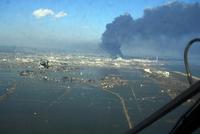
U.S nuclear officials said that there was very little chance that harmful levels of radiation from Japan’s nuclear reactors would reach Hawaii or the west coast of the United States; the head of the Nuclear Regulatory Commission (NRC) also said nuclear plants in the United States were designed to withstand natural disasters like earthquakes and tsunamis; readings from radiation sensors placed on the west coast have not detected any increases in radiation levels and experts do not expect any increases; Japanese utilities have flooded two nuclear reactors with sea water in a desperate attempt to cool them down and prevent a meltdown; the NRC has dispatched two nuclear experts to Japan to assist with efforts to keep three damaged reactors from melting down
-
-
Future of U.S. nuclear plans uncertain after Japanese nuclear crisis
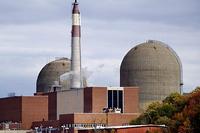
As Japan continues its struggle to control its nuclear reactors, the future of the U.S. nuclear industry has become increasingly uncertain; nuclear power had emerged as the bipartisan solution to easing America’s dependency on oil; in February 2010, President Obama announced $8.3 billion in loan guarantees to energy companies to build the first new nuclear power plants in the United States in almost thirty years; some lawmakers have called for a moratorium and stricter safety regulations, while others are urging for a more measured response; Energy Secretary Stephen Chu and Gregory B. Jaczko, the chairman of the Nuclear Regulatory Commission, will testify before the House Energy and Commerce committee on Wednesday
-
-
Japan facing a nuclear catastrophe
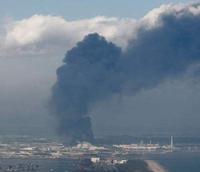
Initial estimates say that the Magnitude 9.0 earthquake and tsunami killed about 10,000 people and made hundreds of thousands homeless; Japan is facing another threat: radioactive contamination from four damaged nuclear power plants; the tremor damaged the cooling systems in the reactors, forcing the companies operating the plants to flood the reactors with corrosive sea water and boric acid; one containment vessel was destroyed in an explosion, and in order to prevent more explosion, radioactive-contaminated hydrogen had to be released, increasing the radioactive levels to unsafe levels; more than 200,000 people living in the vicinity of the reactors were evacuated; the government has began distributing iodine pills to citizens (the pills are used to protect the thyroid gland from the effects of radiation); the difficulties at the nuclear power plants mean that rotating power outages will be imposed across Japan as of Monday
-
-
Sensors detecting nuclear tests detect tsunamis, too
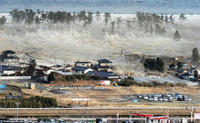
The Comprehensive Nuclear test-Ban Treaty (CTBT) is supported by arrays of sensors at sixty sites across the world that listen for the low boom of atmospheric blasts. They are tuned to infrasound — frequencies under 20 hertz (cycles per second), the lowest humans can hear; these sensors are meant to pick up illicit nuclear tests, but they can also pick up tsunami-producing tremors — and provide timely warning to those likely to be affected
-
-
New tool to build water infrastructure resiliency
The Environmental Protection Agency (EPA) is set to roll out its new Community-Based Water Resiliency (CBWR) Electronic Tool this spring; the tool is designed to give organizations in charge of critical water infrastructure a way to assess their community’s ability to continue delivering water in the event of service disruptions and enhance resiliency; a major natural disaster or terrorist attack could leave large portions of a state without access to drinking water for months; Matthew Everett from the EPA will be present at the upcoming Government and Security Expo to discuss the EPA’s new initiative; the conference will be held from 29 March to 31 March in Washington, D.C.
-
-
Anchorage unprepared for next big quake
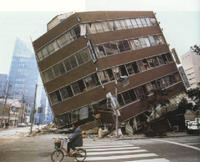
Geologists warn that Alaska’s next big earthquake could be even larger than the Good Friday earthquake of 1964; the massive 9.2 magnitude earthquake is the second largest quake in recorded history and resulted in massive ground failures, tsunamis, and landslides; officials are worried about the Port of Anchorage which lies along an area that is highly susceptible to ground failure; engineers warn that with more than 50 percent of its foundation corroded the port cannot survive another massive quake; large portions of Anchorage are also vulnerable as building codes have not been strictly enforced; the city is built upon a unique soil that is prone to liquefaction in large earthquakes
-
-
New Orleans debates hurricane protection plans
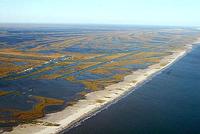
The Army Corps of Engineers is currently deciding how best to implement its $2.9 billion Mississippi River-Gulf Outlet (MR-GO) restoration plan in New Orleans; the plan is part of several projects designed to protect the Louisiana coast line from hurricane storm surges; residents are clashing over the plan and the public hearing period for the plan has been extended; state legislators are currently debating with the corps, as the $2.9 billion project funds do not include the costs for land acquisition, design, and operation and maintenance; the project is expected to take ten years to complete and construction could begin as early as 2012
-
-
Army water contracts fraudster appeals
Last Tuesday, a man convicted of defrauding the U.S military of millions of dollars on water purification contracts requested the Eleventh Circuit Court of Appeals to throw out his 210-month sentence because a key witness was unable to testify; Richard E. Long was convicted of bribery, wire fraud, and money laundering for WATEC, Inc., a Tennessee based firm that provides water purification services to the military; Long accepted $550,000 in bribes in exchange for rewarding contracts worth as much as $66 million to WATEC, Inc.
-
More headlines
The long view
Water Wars: A Historic Agreement Between Mexico and US Is Ramping Up Border Tension
As climate change drives rising temperatures and changes in rainfall, Mexico and the US are in the middle of a conflict over water, putting an additional strain on their relationship. Partly due to constant droughts, Mexico has struggled to maintain its water deliveries for much of the last 25 years, deliveries to which it is obligated by a 1944 water-sharing agreement between the two countries.
Trump Is Fast-Tracking New Coal Mines — Even When They Don’t Make Economic Sense
In Appalachian Tennessee, mines shut down and couldn’t pay their debts. Now a new one is opening under the guise of an “energy emergency.”
Smaller Nuclear Reactors Spark Renewed Interest in a Once-Shunned Energy Source
In the past two years, half the states have taken action to promote nuclear power, from creating nuclear task forces to integrating nuclear into long-term energy plans.
Keeping the Lights on with Nuclear Waste: Radiochemistry Transforms Nuclear Waste into Strategic Materials
How UNLV radiochemistry is pioneering the future of energy in the Southwest by salvaging strategic materials from nuclear dumps –and making it safe.
Model Predicts Long-Term Effects of Nuclear Waste on Underground Disposal Systems
The simulations matched results from an underground lab experiment in Switzerland, suggesting modeling could be used to validate the safety of nuclear disposal sites.
